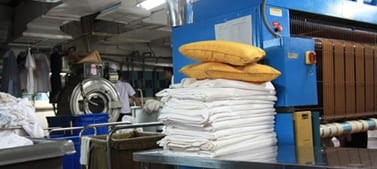Thermal oil systems used to heat flatwork ironers are becoming popular and offering greater productivity per unit floor space. System corrosion, steam trap maintenance and condensate return are eliminated. There is no discharge problem or water treatment, and operating costs are significantly reduced through system efficiencies. Furthermore, in most areas of the country there is no need for expensive licensed operating engineers.

Productivity
While steam systems usually operate to 350 °F, thermal oil systems can effortlessly provide 450 °F – with the pump discharge providing only adequate pressure to overcome pipe friction. To compare, an oil heated 3-chest ironer with parallel flow is capable of providing about the same output as a 5-chest steam-heated unit.
The low pressures common in thermal oil systems allow the chests to be fabricated of steel rather than the cast-iron needed for steam systems. Not only is this a cost savings, but also improves heat transfer with steel, and the lower number of chests saves valuable floor space.
Maintenance
With steam systems, corrosion is considered to be a foregone conclusion. The goal here is to reduce corrosion as much as possible, mainly through water treatment – which is time consuming and expensive. Due to corrosion, traps and other components must be continuously maintained.
Thermal oils will not corrode the materials commonly employed in laundry systems. Oils in fact provide a protective coating to metals in the system and also offer high lubricity to moving parts. Additionally, barring leaks or spills, no make-up is necessary.
Environmental Concerns
The water used in a steam system must be treated in order to reduce corrosion and increase lubricity, among various other requirements. The chemicals used, in certain cases, are considered regulated and/or hazardous wastes. System leaks and blowdown must be closely monitored, and the system’s water cannot be allowed to flow into waterways or enter floor drains. There is no blowdown in thermal oil systems. It is possible to handle spills using the same procedures used for releases of lubricating oils.
Operating Costs
Steam systems lose energy through flash, de-aeration cycles and blowdown. Thermal oil systems working at higher temperatures use less fuel as these losses are eliminated.
Licensed Operating Engineers
A steam system operating at 350 °F, produces 120 psig. At these pressures, most states need a licensed operating engineer to be employed in order to supervise the system. Thermal oil systems work at pressures dictated by the discharge of the pump, static head of the expansion tank and vapor pressure of the fluid (usually well below atmospheric).
If high pressure steam is needed, the laundry can specify the use of an unfired, tube steam generator and hot oil heated shell. Thermal fluid heat exchanges can produce hot water and also hot air. These units have proven exceptionally reliable. In hot water exchangers, fouling tends to happen a lot more slowly than fired steam, mainly due to the low heat flux.
System Economics
A thermal-oil heater costs more than a steam boiler. However, a 3 or 4-chest oil-heated ironer costs less than a 5 or 6-chest steam heated unit. With thermal oil, extra savings are generated in the elimination of blow down, deaeration and chemicals used to treat the water, not to mention low maintenance, tight temperature control and smooth operation. The biggest savings involve the elimination of the licensed operating engineer. If local regulations allow this with thermal oil systems (as many do), the balance swings heavily in favor of the oil system.
The consultation of a competent engineering consultant is strongly recommended, for a detailed evaluation of requirements and a balanced approach to the decision for thermal oil or steam.
Notes:
- It is strongly recommended to consider an expansion tank equipped with a cold-seal tank, or inert gas blanketing. These can largely eliminate oxidation of the heat transfer fluid. One of the most insidious types of fluid degradation, oxidation, is discussed more thoroughly in the data sheet entitled “Oxidation in Heat Transfer Fluids”.
- In selecting a heat transfer fluid for use in laundries, these areas should be given importance:
- Flash point. The Paratherm HE fluid has a closed-cup flash point of 410 °F, which is greater than the operating temperature of the ironer.
- Low vapor pressure. Vapor pressure of the HE fluid is among the lowest of any fluid available.
- Non-toxicity. The HE fluid is non-toxic and has passed stringent Bioassay, while many heat transfer fluids are considered regulated waste and/or hazardous.
Broad industry acceptance. The HE fluid is presently used in an extensive range of hotel, institutional and central laundries and is fully approved by key manufacturers of laundry equipment.

This information has been sourced, reviewed and adapted from materials provided by Paratherm.
For more information on this source, please visit Paratherm.